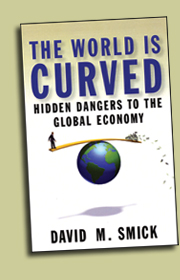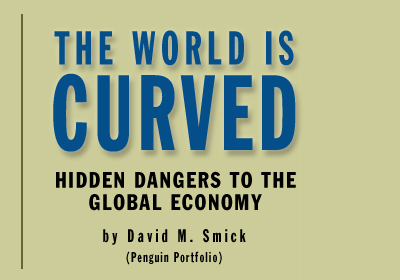 |
 |
 |
 |
|
|
A conversation with the author
Why did you write this book? Today the world financial system is still near a dangerous tipping point of uncertainty and chaos. The mortgage crisis was only the beginning. Yet our politicians, from both political parties, fixate on the trivial. Our financial house is on fire, yet our leaders are squabbling over arranging the furniture in the front parlor. Instead, they desperately need to develop a “big think” doctrine that defines America’s economic and financial future in the world. The title The World Is Curved is sure to draw comparisons with Tom Friedman’s book The World Is Flat. Why did you select the title? Why is the world now curved? Was it ever flat? Friedman brilliantly presents the first installment of the globalization story, concentrating on the revolutionizing (flattening) of the global supply chain. But there is a second installment—the financial side of the story where the world is not flat; the world is curved. You can’t see over the horizon. Sight lines are limited. As during the subprime mortgage crisis, we are forced to travel down an endless, dangerously twisting and turning road of volatility with steep valleys and risky mountainous climbs. We can’t see financial risk ahead. A small village in Arctic Norway can see its entire financial future destroyed because its financial managers invested heavily in a Citigroup product called a collateralized debt obligation. How does The World Is Curved differ from other books about our current economic state? The book demystifies the complicated and terrifying world of international finance. This is a practical, insider’s guide to the revolution in global financial markets. I offer numerous anecdotes about my behind-the-scenes experiences in the hedge fund world and in key meetings with prime ministers, finance ministers, and central bankers, from Alan Greenspan to Ben Bernanke to the European Central Bank’s Jean-Claude Trichet. The book is both frightening yet hopeful. Why did you feel that now was the time to write this book? Globalization, the great paradox of our time, has been an impressive wealth-creating, poverty-reducing machine. In the last quarter-century of globalized markets, the Dow jumped from 800 to well over 12,000. To match that success the next twenty-five years, the Dow would have to exceed 170,000. Yet the fruits of globalization are distributed unequally. Globalization itself produces huge pangs of anxiety for average working Americans. Oil and food prices have skyrocketed. There is no denying the globalized financial system both enables and threatens our national well-being. In this year’s election, candidates must confront this paradox. How would you define the future of globalization? It depends on how politicians and policymakers respond to the fallout from the Great Credit Crisis of 2007–2008. The subprime mortgage crisis exacerbated an ongoing collapse of confidence in the sophisticated financial instruments banks use to diversify and reduce risk. The Federal Reserve, in particular, was caught asleep at the switch. Ultimately, however, the greed-driven bankers and investment bankers deserve the most blame. They set up dubious, off-balance-sheet vehicles to hide risk. The lack of transparency created a global crisis of confidence that nearly tanked the world economy and now threatens the future of liberalized capital markets. Are we still in trouble? The world still faces a trillion-dollar credit problem. When the credit crisis hit in August 2007, the world’s central banks flooded the global economy with liquidity to avoid immediate disaster. Luckily, today’s policymakers have learned from the mistakes made in the 1930s. The Federal Reserve also placed all U.S. financial institutions under the government “safety net.” Sounds reassuring, but the credit contraction is still likely to linger for years, and could become worse if policymakers aren’t careful. In the face of today’s powerful ocean of capital, there are limits to the effectiveness of government solutions. Are the banks still at risk? Consider the case of UBS, Switzerland’s largest bank with major links to the United States. Today, UBS’s total financial exposure is more than four times the size of Switzerland’s GDP. Translation: In a crisis, the government couldn’t bail out the bank even if it wanted to. The rest of the world faces a similar scary situation. True, central banks can forever print money to try to prop up the banks, but even then there are limits because of the potential outbreak of inflation. So what happens when the next financial crisis hits? The survival of the world financial system, including our ability to protect the savings and livelihoods of average families, depends on an elaborate game of confidence. Confidence comes from market participants believing policymakers know what they are doing in a system of relatively complete and open transparency. Whether we’re prepared for the next crisis depends on the job our policymakers do in restoring confidence. Why was it so monumental that the Fed stepped in with the Bear Stearns situation? Friends of mine at the Fed say there was no other choice. I have no reason to doubt them. A collapse of the Wall Street firm Bear Stearns, as the devastation rippled throughout the financial system, would have savaged the pocketbooks and pensions of every working American. Still, policy moves have unintended consequences. The Fed appears to have placed a government guarantee under the entire U.S. financial system, not just the banks. Sounds great, but some new, all-encompassing regulatory structure is therefore needed to protect the public interest at a time of financial deleveraging. That means the profitability of the U.S. financial services industry will decline. The bad news is that the health of a nation’s financial industry is key to future levels of entrepreneurial initiative and overall prosperity. You talk about the “incredible shrinking central banks.” What does the decline in power of the central banks mean for the future of the world economy? People picture central banks as having magical powers to step in and save the day. Dream on. I have known most of the world’s central bankers in recent decades, including Paul Volcker, Alan Greenspan, and Ben Bernanke. All would admit the power of the central bank is rapidly diminishing. Worse, in the case of the United States, interest rates have increasingly become a captive of global financial forces. To a certain extent, therefore, Americans are no longer in complete control of their own monetary policy. That is why central banks, led by the Fed, have become a kind of grand global theater. Because the world’s ocean of capital is so huge and powerful, the central bankers have had no choice but to become the lead actors. They use their dramatic skills to try to tease, persuade, charm, and bluff the markets. And of course the Lawrence Olivier of this process was Alan Greenspan. It’s not quite like The Wizard of Oz with the little man behind the curtain pulling the levers, but the analysis is not completely off the mark. In the end, the incredible shrinking of central bank influence over financial markets is a primary reason the world is curved. So what’s the future of the world financial system? The financial world is still a dangerous place. That’s because the world is flirting with moving away from the last quarter-century’s model of globalization and free-flowing capital markets toward something more reminiscent of the nineteenth-century mercantilist economic model. What I’m describing is an era of backroom rivalries, deal making, and tensions based on ambitious national political agendas with capital flows, and commodities led by oil, increasingly controlled by governments. One does not have to be a rocket scientist to see the picture emerging: financial wealth and power are moving away from the United States, Europe, and Japan. What does this shift mean for the United States in particular, for the jobs and savings of average Americans? Globalization has produced an ocean of capital that swirls around the world at the push of a button. The good news is that despite the United States running current account and budget imbalances since the 1980s, real interest rates have steadily declined and the economy has prospered with vigorous job creation. Yet America must still put its fiscal house in order and set out on a path toward energy independence. Ultimately, however, the future depends on whether the American economy can remain an attractive target for global capital as a focal point for financial safety and entrepreneurial creativity. On this question the jury is still out. Policy matters. If in the next few years our leaders make the correct choices, we can avoid catastrophe and continue the prosperity. But there is no denying the world is at serious risk. Your comments about doing business in China seem to counter the popular perception that it’s a place where businesses and entrepreneurs should focus their energy. Why do you feel that way? Absolutely nothing about the churning cauldron we call China can be taken for granted. With its rising social, political, and financial instability, China represents a powerful case for why the world is curved. When the Chinese bubble bursts—and they almost always do—the entire world economy will be at risk, most likely from a massive deflationary spiral that will, when all is said and done, hit everyone’s pocketbooks. If transparency is the key to the long-term stability of global financial markets, what do any of us really know about the future of China? Economically speaking, China today is the size of three Hollands. Yet recently, China overtook the United States as the largest source of greenhouse gases. Therefore, China’s environmental policies are now on a dangerous collision course with its trade goals. In general, the Chinese leadership is attempting to control and direct an unwieldy, chaotic, highly unpredictable economic and financial beast. The job may be impossible. Where does Japan fit into the global picture? Japan is the perfect object lesson for how not to run things in the new global economy. A highly successful economy requires a continual process of entrepreneurial reinvention, which is not occurring in Japan. Moreover, Japan is what the United States could become if American policymakers are not careful—so overloaded with debt that monetary policy becomes largely ineffective at stimulating the economy. Today, the Japanese financial system has become far more decentralized. Who now controls the bulk of the country’s savings? Housewives, who increasingly bypass low-yielding Japanese investments and purchase foreign bonds over the Internet. The housewives control the largest pool of money in the world. They have become a major force in foreign exchange markets, and a significant wild card. What do you hope readers take away from The World Is Curved? The global financial system is near a tipping point of uncertainty and could come crashing down to the detriment of all of us. Protectionist and class warfare policies, and other policy prescriptions to curb reckless volatility, may be well-intended efforts to deal with the anxieties of global trade and financial markets. But the danger is that they produce unintended consequences that could send us over the edge. What’s the most important thing to watch in the years ahead? Without a doubt it’s whether policymakers allow the continual free flow of international capital to keep globalization’s bloodstream pumping. Kill capital flows and you’ll kill the global economy. The problem is that the world today lacks a financial doctrine, or even much in the way of a set of informal understandings, for establishing order in a crisis. Instead, we grope and manage incrementally, like trying to perform delicate brain surgery with one hand tied behind our back and the other wearing an ill-fitting boxing glove. Today is very similar to an earlier period of globalization and prosperity, from 1880–1914, which ended with World War I. Soon the seeds were planted for an economic depression. The world can’t let that happen again. My book calls for a new financial order and offers other recommendations for surviving and prospering in a “curved” world.
|
| Copyright © 2008
David M. Smick All Rights Reserved. |